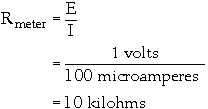3-14
Since the normal voltage drop for the meter is 10 millivolts at full-scale deflection, some means must
be supplied to drop the extra 9.99 volts without applying it directly to the meter. This is done by the
addition of a multiplier resistor, as shown in figure 3-9.
Extending Voltmeter Ranges
The value of series resistance is determined by the current required for full-scale deflection and by
the range of the voltages to be measured. Since the current through the meter circuit is directly
proportional to the applied voltage, the meter scale can be calibrated directly in volts for a fixed value of
series resistance. For example, let’s assume that the basic meter is to be made into a voltmeter with a full-
scale deflection of 1 volt. The coil resistance of the basic meter is 100 ohms, and 100 microamperes of
current causes full-scale deflection. The resistance (R
meter) required to limit the total current in the circuit
to 100 microamperes can be found as follows:
Because the meter coil already measures 100 ohms, the series resistance required is equal to 10
kilohms minus 100 ohms, or 9.9 kilohms.
Q-16. What factors determine the value of the multiplier resistor?
Multirange voltmeters use one meter movement. The required resistances are connected in series
with the meter by a switching arrangement. A schematic diagram of a multirange voltmeter with three
ranges is shown in figure 3-10. The total meter resistance (R
meter) for each of the three ranges, beginning
with the 1-volt range, is figured by the application of Ohm’s law, as follows:



